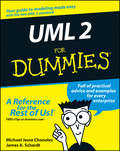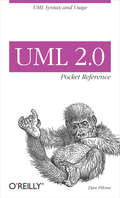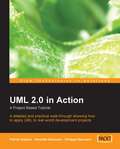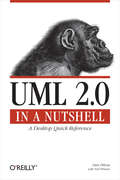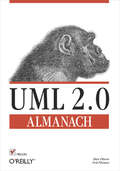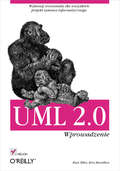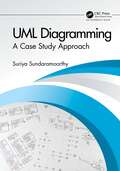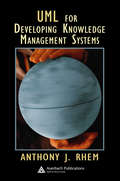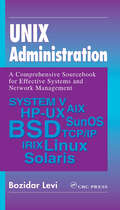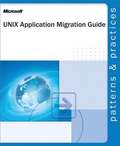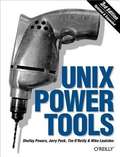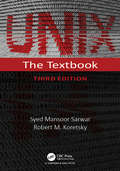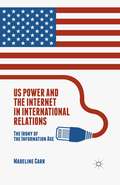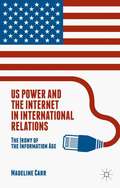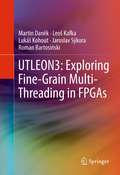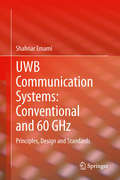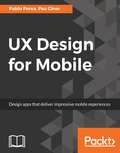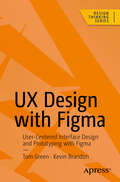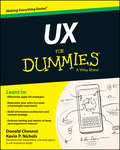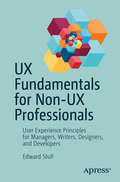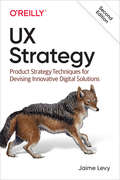- Table View
- List View
UML 2 For Dummies (For Dummies Ser.)
by James A. Schardt Michael Jesse ChonolesUses friendly, easy-to-understand For Dummies style to help readers learn to model systems with the latest version of UML, the modeling language used by companies throughout the world to develop blueprints for complex computer systems Guides programmers, architects, and business analysts through applying UML to design large, complex enterprise applications that enable scalability, security, and robust execution Illustrates concepts with mini-cases from different business domains and provides practical advice and examples Covers critical topics for users of UML, including object modeling, case modeling, advanced dynamic and functional modeling, and component and deployment modeling
UML 2.0 Pocket Reference: UML Syntax and Usage (Pocket Reference (O'Reilly))
by Dan PiloneGlobe-trotting travelers have long resorted to handy, pocket-size dictionaries as an aid to communicating across the language barrier. Dan Pilone's UML 2.0 Pocket Reference is just such an aid for on-the-go developers who need to converse in the Unified Modeling Language (UML). Use this book to decipher the many UML diagrams you'll encounter on the path to delivering a modern software system. Updated to cover the very latest in UML, you'll find coverage of the following UML 2.0 diagram types:Class diagramsComponent diagrams*Sequence diagrams*Communication diagrams*Timing diagrams*Interaction Overview diagrams*Package diagrams*Deployment diagrams*Use case diagramsComposite structure diagrams*Activity diagrams*Statechart diagrams** New or expanded coverage in this edition Also new in this edition is coverage of UML's Object Constraint Language (OCL). Using OCL, you can specify more narrowly the functionality described in a given diagram by recording limits that are the result of business rules and other factors. The UML 2.0 Pocket Reference travels well to meetings and fits nicely into your laptop bag. It's near impossible to memorize all aspects of UML, and with this book along, you won't have to.
UML 2.0 in Action: A project-based tutorial
by Barrie Dempster Philippe Baumann Patrick GrassleThe book is uniquely practical. A richly textured case study is used throughout the book. Although some aspects of the Airport Passenger Services business process are simplified for sake of clarity and efficiency, it provides a comprehensive practical grounding for theoretical UML knowledge. The case study itself was developed in partnership with employees of Zurich Airport. The book was written for business analysts, technical architects and developers. It does not require detailed programming knowledge, nor is prior experience of UML mandatory. It shows how, with UML, simple models of business processes and specification models can be created and read with little effort.
UML 2.0 in a Nutshell: A Desktop Quick Reference
by Dan Pilone Neil PitmanSystem developers have used modeling languages for decades to specify, visualize, construct, and document systems. The Unified Modeling Language (UML) is one of those languages. UML makes it possible for team members to collaborate by providing a common language that applies to a multitude of different systems. Essentially, it enables you to communicate solutions in a consistent, tool-supported language.Today, UML has become the standard method for modeling software systems, which means you're probably confronting this rich and expressive language more than ever before. And even though you may not write UML diagrams yourself, you'll still need to interpret diagrams written by others.UML 2.0 in a Nutshell from O'Reilly feels your pain. It's been crafted for professionals like you who must read, create, and understand system artifacts expressed using UML. Furthermore, it's been fully revised to cover version 2.0 of the language.This comprehensive new edition not only provides a quick-reference to all UML 2.0 diagram types, it also explains key concepts in a way that appeals to readers already familiar with UML or object-oriented programming concepts.Topics include:The role and value of UML in projectsThe object-oriented paradigm and its relation to the UMLAn integrated approach to UML diagramsClass and Object, Use Case, Sequence, Collaboration, Statechart, Activity, Component, and Deployment DiagramsExtension MechanismsThe Object Constraint Language (OCL)If you're new to UML, a tutorial with realistic examples has even been included to help you quickly familiarize yourself with the system.
UML 2.0. Almanach
by Dan Pilone Neil PitmanWyczerpuj?cy przewodnik po j?zyku UML 2.0 Specyfikacja j?zyka UML 2.0 Modelowanie statyczne i dynamiczne Rozszerzanie i zastosowania UML-a Ujednolicony j?zyk modelowania (UML) pocz?tkowo s?u?y? do opisu elementów oprogramowania, jednak z powodu swej elegancji i przejrzysto?ci zyskuje na popularno?ci w zakresie modelowania zagadnie? z innych dziedzin. W zwi?zku z tym coraz wi?cej osób ma szans? zetkn?? si? z diagramami w j?zyku UML. Je?li si?gn??e? po t? ksi??k?, prawdopodobnie czeka to tak?e Ciebie. Chcia?by? wiedzie?, co oznaczaj? ró?ne zako?czenia linii na diagramach klas albo zrozumie? skomplikowany diagram interakcji? Zajrzyj do ?rodka. "UML 2.0. Almanach" to kompletny podr?cznik dla u?ytkowników tego j?zyka. Dzi?ki tej ksi??ce poznasz podstawy modelowania w UML-u. Nauczysz si? tworzy? i rozumie? diagramy statyczne, na przyk?ad klas, pakietów czy struktur z?o?onych, a tak?e diagramy zachowania, takie jak przypadków u?ycia, aktywno?ci czy interakcji. Dowiesz si?, jak wszechstronne zastosowania ma ten j?zyk oraz w jaki sposób mo?na go rozszerza? do wykonywania specyficznych zada?. Znajdziesz tu tak?e krótkie wprowadzenie do j?zyka Object Constraint Language (OCL) oraz architektury sterowanej modelem (MDA). Podstawy modelowania w UML-u Diagramy statyczne i diagramy zachowania Dobór odpowiedniego rodzaju diagramu Znaczenie symboli, notacji i linii Rozszerzanie UML-a za pomoc? etykiet, stereotypów i profili Architektura sterowana modelem J?zyk Object Constraint Language (OCL) Praktyczne wskazówki z zakresu modelowania Poznaj tajniki modelowania w j?zyku UML 2.0
UML 2.0. Wprowadzenie
by Kim Hamilton Russ MilesNajtrudniejszym etapem ka?dego procesu tworzenia systemu informatycznego jest wykonanie odpowiedniego projektu. Umiej?tno?? pogodzenia wymaga? u?ytkowników i osób finansuj?cych system z mo?liwo?ciami oferowanymi przez technologi? jest kluczowym elementem sukcesu. Im bardziej z?o?ony system, tym bardziej zawi?y staje si? projekt. Konieczno?? ustandaryzowana technik projektowania systemów zaowocowa?a powstaniem narz?dzi, dzi?ki którym nawet najbardziej skomplikowany projekt mo?na przedstawi? w prosty i czytelny sposób. Takim narz?dziem jest notacja UML -- zestaw ikon tworz?cych diagramy opisuj?ce system i jego elementy. Ksi??ka "UML 2.0. Wprowadzenie" w praktyczny sposób przedstawia techniki modelowania systemów informatycznych za pomoc? j?zyka UML 2.0. Czytaj?c j?, nauczysz si? graficznie przedstawia? otoczenie systemu, wymagania stawiane przez u?ytkowników i metody ich implementacji w systemie. Utworzysz diagramy klas, interakcji, komponentów, wdro?enia i inne, które opisuj? projekt w jednoznaczny oraz prosty sposób. Dowiesz si? tak?e, jak zaplanowa? proces wdro?enia produktu za pomoc? UML. Elementy j?zyka UML Modelowanie wymaga? za pomoc? przypadków u?ycia Diagramy czynno?ci i sekwencji Modelowanie klas i powi?za? pomi?dzy nimi Diagramy komponentów Podzia? modelu na pakiety Modelowanie wdro?enia systemu Poznaj nowoczesne metody projektowania systemów informatycznych.
UML Diagramming: A Case Study Approach
by Suriya SundaramoorthyThe Unified Modeling Language, better known as UML, has become the de facto standard modeling language for analyzing and designing software applications and systems. Software analysis and design is just as much an art as it is a science. UML Diagramming: A Catalog of Cases shows the art and the science behind successful software analysis and design with more than 35 case studies of applications of a variety of industries, including: Transportation Healthcare Supply chain management Education Agriculture Manufacturing The book explains UML diagramming through case studies to help systems and software developers specify, visualize, construct, and document the artifacts of software systems. The cases demonstrate how UML embodies software engineering best practices for modeling large and complex systems. They show how UML is an intuitive diagramming language that can be easily understood by end-users and business professionals. These cases studies also demonstrate how UML is a powerful language for communicating software designs to help developers and end users validate application scope, requirements, and features. Case studies highlighted in the book included: WEBMED healthcare service system services Inventory management system Business process outsourcing (BPO) management system Weather monitoring system Product recommendation system Textile management system Smart traffic management system Online pharmacy management system Placement automation system Farm management system Art gallery management system Website development This catalog of UML case studies is an invaluable reference for students studying software engineering, programmers starting out their careers, and seasoned systems developers needing a reference guide.
UML for Developing Knowledge Management Systems
by Anthony J. RhemUML for Developing Knowledge Management Systems provides knowledge engineers the framework in which to identify types of knowledge and where this knowledge exists in an organization. It also shows ways in which to use a standard recognized notation to capture, or model, knowledge to be used in a knowledge management system (KMS).This volume
UNIX Administration: A Comprehensive Sourcebook for Effective Systems & Network Management (Internet and Communications)
by Bozidar LeviTo configure and maintain an operating system is serious business. With UNIX and its wide variety of "flavors," it can be especially difficult and frustrating, and networking with UNIX adds still more challenges.UNIX Administration: A Comprehensive Sourcebook for Effective Systems & Network Management is a one-stop handbook
UNIX Application Migration Guide
by Microsoft CorporationDrawing on the experience of Microsoft consultants working in the field, as well as external organizations that have migrated from UNIX to Microsoft® Windows®, this guide offers practical, prescriptive guidance on the issues you are likely to face when porting existing UNIX applications to the Windows operating system environment. Senior IT decision makers, network managers, and operations managers will get real-world guidance and best practices on planning and implementation issues to understand the different methods through which migration or co-existence can be accomplished. Also detailing changes required at the coding level, this guide is a valuable resource for both UNIX programmers and Windows programmers. All PATTERNS & PRACTICES guides are reviewed and approved by Microsoft engineering teams, consultants, partners, and customers--delivering accurate, real-world information that's been technically validated and tested.
UNIX For Dummies, 5th Edition
by John R. Levine Margaret Levine YoungUNIX For Dummies has been the standard for beginning UNIX references for nearly ten years, and this latest edition continues that tradition of success This unparalled resource is updated to cover the latest applications of UNIX technology, including Linux and Mac desktops as well as how UNIX works with Microsoft server software Thorough coverage of how to handle UNIX installation, file management, software, utilities, networks, Internet access, and other basic tasks Aimed at the first-time UNIX desktop user growing accustomed to the ins and outs of the OS, as well as the beginning administrator who needs to get a handle on UNIX networking basics Written by John Levine and Margaret Levine Young, longtime UNIX experts and highly experienced For Dummies authors
UNIX Power Tools, 3rd Edition
by Shelley Powers Jerry Peek Tim O'Reilly Mike LoukidesThe latest edition of this best-selling favorite is loaded with vital information on Linux, Darwin, and BSD. Unix Power Tools 3rd Edition now offers more coverage of bash, zsh, and other new shells, along with discussions about modern utilities and applications. Several sections focus on security and Internet access. There is a new chapter on access to Unix from Windows, and expanded coverage of software installation and packaging, as well as basic information on Perl and Python.
UNIX Unbounded: A Beginning Approach
by Amir AfzalUNIX Unbounded: A Beginning Approach is ideal for introductory courses in the UNIX operating system. It is also serves as a suitable introduction to UNIX for professionals. Using clear-cut examples, this tutorial introduces readers to the UNIX operating system, including its historical development, major versions, and important features. It covers the topics necessary for users to function independently and handle routine tasks, giving readers a foundation for exploring more advanced UNIX topics.
UNIX in a Nutshell: System V Edition
by Arnold RobbinsThe bestselling, most informative Unix reference book is now more complete and up to date. Not a scaled-down quick reference of common commands, UNIX in a Nutshell is a complete reference containing all commands and options, with descriptions and examples that put the commands in context. For all but the thorniest Unix problems, this one reference should be all you need. Covers System V Release 4 and Solaris 7.
UNIX: The Textbook, Third Edition
by Syed Mansoor Sarwar Robert M. KoretskyUNIX: The Textbook, Third Edition provides a comprehensive introduction to the modern, twenty-first-century UNIX operating system. The book deploys PC-BSD and Solaris, representative systems of the major branches of the UNIX family, to illustrate the key concepts. It covers many topics not covered in older, more traditional textbook approaches, such as Python, UNIX System Programming from basics to socket-based network programming using the client-server paradigm, the Zettabyte File System (ZFS), and the highly developed X Windows-based KDE and Gnome GUI desktop environments. The third edition has been fully updated and expanded, with extensive revisions throughout. It features a new tutorial chapter on the Python programming language and its use in UNIX, as well as a complete tutorial on the git command with Github. It includes four new chapters on UNIX system programming and the UNIX API, which describe the use of the UNIX system call interface for file processing, process management, signal handling, interprocess communication (using pipes, FIFOs, and sockets), extensive coverage of internetworking with UNIX TCP/IP using the client-server software, and considerations for the design and implementation of production-quality client-server software using iterative and concurrent servers. It also includes new chapters on UNIX system administration, ZFS, and container virtualization methodologies using iocage, Solaris Jails, and VirtualBox. Utilizing the authors’ almost 65 years of practical teaching experience at the college level, this textbook presents well-thought-out sequencing of old and new topics, well-developed and timely lessons, a Github site containing all of the code in the book plus exercise solutions, and homework exercises/problems synchronized with the didactic sequencing of chapters in the book. With the exception of four chapters on system programming, the book can be used very successfully by a complete novice, as well as by an experienced UNIX system user, in both an informal and formal learning environment. The book may be used in several computer science and information technology courses, including UNIX for beginners and advanced users, shell and Python scripting, UNIX system programming, UNIX network programming, and UNIX system administration. It may also be used as a companion to the undergraduate and graduate level courses on operating system concepts and principles.
US Power and the Internet in International Relations: The Irony of the Information Age
by M. CarrDespite the pervasiveness of the Internet and its importance to a wide range of state functions, we still have little understanding of its implications in the context of International Relations. Combining the Philosophy of Technology with IR theories of power, this study explores state power in the information age.
US Power and the Internet in International Relations: The Irony of the Information Age
by Madeline CarrDespite the pervasiveness of the Internet and its importance to a wide range of state functions, we still have little understanding of its implications in the context of International Relations. Combining the Philosophy of Technology with IR theories of power, this study explores state power in the information age.
UTLEON3: Exploring Fine-Grain Multi-Threading in FPGAs
by Martin Daněk Lukáš Kohout Jaroslav Sýkora Roman Bartosiński Leoš KafkaThis book describes a specification, microarchitecture, VHDL implementation and evaluation of a SPARC v8 CPU with fine-grain multi-threading, called micro-threading. The CPU, named UTLEON3, is an alternative platform for exploring CPU multi-threading that is compatible with the industry-standard GRLIB package. The processor microarchitecture was designed to map in an efficient way the data-flow scheme on a classical von Neumann pipelined processing used in common processors, while retaining full binary compatibility with existing legacy programs.
UWB Communication Systems: Conventional and 60 GHz
by Shahriar EmamiIn this book the author examines 60 GHz and conventional UWB. The book introduces the fundamentals, architectures, and applications of unified ultra wideband devices. The material includes both theory and practice and introduces ultra wideband communication systems and their applications in a systematic manner. The material is written to enable readers to design, analyze, and evaluate UWB communication systems.
UX Design for Mobile
by Pablo Perea Pau GinerThis book is for designers, developers and product managers interested in creating successful apps. Readers will be provided with a process to produce, test and improve designs based on best practices.
UX Design with Figma: User-Centered Interface Design and Prototyping with Figma (Design Thinking)
by Tom Green Kevin BrandonMaximize Figma’s arsenal of tools and plugins within a team-based collaborative environment and accelerate your company’s decision making. This book will show you where Figma fits into the user experience (UX) design process from documentation to developer handoff. Since its release as a browser-based design tool in 2016, Figma has fast become the de facto UX Design tool for the industry mainly due to its accessibility and ease of use. As you move through the book you will learn where Figma fits in the UX process. For example, using FigJam (an online whiteboard) for brainstorming, and creating interactive prototypes for mobile devices, tablets, and web sites. You’ll also see how Figma is used to create and integrate with design systems, and how variables, when applied to design system components, can accelerate the design and development workflow. With the help of step-by-step examples, and using Figma’s tools and templates, you’ll create artifacts such as Flow and Journey diagrams, Personas, and wireframes. From there you will explore other design and interactivity features, and how to prepare a Figma file for handoff to a development team. This book is your roadmap to utilizing Figma, the industry’s fastest growing collaborative design tool for building meaningful products. What You Will Learn Create interactive prototypes Test and submit designs for team review Understand the collaborative workflow involved in an UX project Prepare common UX documentation Who This Book Is For Designers, developers, and UX specialists with little-to-no Figma experience who are looking to integrate it within their workflows, and intermediate Figma users who are just starting to become involved in the collaborative UX workflow.
UX For Dummies
by Donald Chesnut Kevin NicholsGet up to speed quickly on the latest in user experience strategy and designUX For Dummies is a hands-on guide to developing and implementing user experience strategy. Written by globally-recognized UX consultants, this essential resource provides expert insight and guidance on using the tools and techniques that create a great user experience, along with practical advice on implementing a UX strategy that aligns with your organisation's business goals and philosophy. You'll learn how to integrate web design, user research, business planning and data analysis to focus your company's web presence on the needs of your customers, gaining the skills you need to be effective in the field of user experience design.Whether it's the interface, graphics, industrial design, physical interaction or a user manual, being anything less than on point can negatively affect customer satisfaction and retention. User experience design fully encompasses traditional human-computer interaction design, and extends it to address all aspects of a product or service as perceived by users. UX For Dummies provides comprehensive guidance to professionals looking to understand and apply effective UX strategies.Defines UX and offers assistance with determining users and modelling the user experienceProvides details on creating a content strategy and building information architecturesExplores visual design and designing for specific channelsDelves into UX testing and methods for keeping your site relevantThe UX field is growing rapidly as companies realise that meeting your business goals requires a web presence aligned with customer needs. This alignment demands smart strategy and even smarter design. Consultants, designers and practitioners must all be on board if the result is to be cohesive and effective. UX For Dummies provides the information and expert advice you need to get up to speed quickly.
UX Fundamentals for Non-UX Professionals: User Experience Principles for Managers, Writers, Designers, and Developers
by Edward StullDemystify UX and its rules, contradictions, and dilemmas. This book provides real-world examples of user experience concepts that empower teams to create compelling products and services, manage social media, interview UX candidates, and oversee product teams.From product decisions to performance reviews, your ability to participate in discussions about UX has become vital to your company's success as well as your own. However, UX concepts can seem complex. Many UX books are written by and for UX professionals. UX Fundamentals for Non-UX Professionals serves the needs of project managers, graphic designers, copyeditors, marketers, and others who wish to understand UX design and research.You will discover how UX has influenced history and continues to affect our daily lives. Entertaining real-world examples demonstrate what a massive, WWII-era tank teaches us about design, what a blue flower tells us about audiences, and what drunk marathoners show us about software.What You'll LearnKnow the fundamentals of UX through real-world examples Acquire the skills to participate intelligently in discussions about UX design and researchUnderstand how UX impacts business, including product, pricing, placement, and promotion as well as security, speed, and privacyWho This Book Is ForProfessionals who work alongside UX designers and researchers, including but not limited to: project managers, graphic designers, copyeditors, developers, and human resource professionals; and business, marketing, and computer science students seeking to understand how UX affects human cognition and memory, product pricing and promotion, and software security and privacy.
UX Research: Practical Techniques for Designing Better Products
by Brad Nunnally David FarkasOne key responsibility of product designers and UX practitioners is to conduct formal and informal research to clarify design decisions and business needs. But there’s often mystery around product research, with the feeling that you need to be a research Zen master to gather anything useful. Fact is, anyone can conduct product research. With this quick reference guide, you’ll learn a common language and set of tools to help you carry out research in an informed and productive manner.This book contains four sections, including a brief introduction to UX research, planning and preparation, facilitating research, and analysis and reporting. Each chapter includes a short exercise so you can quickly apply what you’ve learned.Learn what it takes to ask good research questionsKnow when to use quantitative and qualitative research methodsExplore the logistics and details of coordinating a research sessionUse softer skills to make research seem natural to participantsLearn tools and approaches to uncover meaning in your raw dataCommunicate your findings with a framework and structure
UX Strategy: How To Devise Innovative Digital Products That People Want
by Jaime LevyUser experience (UX) strategy lies at the intersection of UX design and business strategy, but until now, there hasn't been an easy-to-apply framework for executing it. This hands-on guide introduces lightweight product strategy tools and techniques to help you and your team devise innovative digital solutions that people want.Author Jaime Levy shows UX/UI designers, product managers, entrepreneurs, and aspiring strategists simple to advanced methods that can be applied right away. You'll gain valuable perspective through business cases and historical context. This second edition includes new real-world examples, updated techniques, and a chapter on conducting qualitative online user research.Define value propositions and validate target users through provisional personas and customer discovery techniquesExplore marketplace opportunities by conducting competitive research and analysisDesign experiments using rapid prototypes that are focused on the business modelConduct online user research to gain valuable insights quickly on any budgetTest business ideas and validate marketing channels by running online advertising and landing page campaigns
